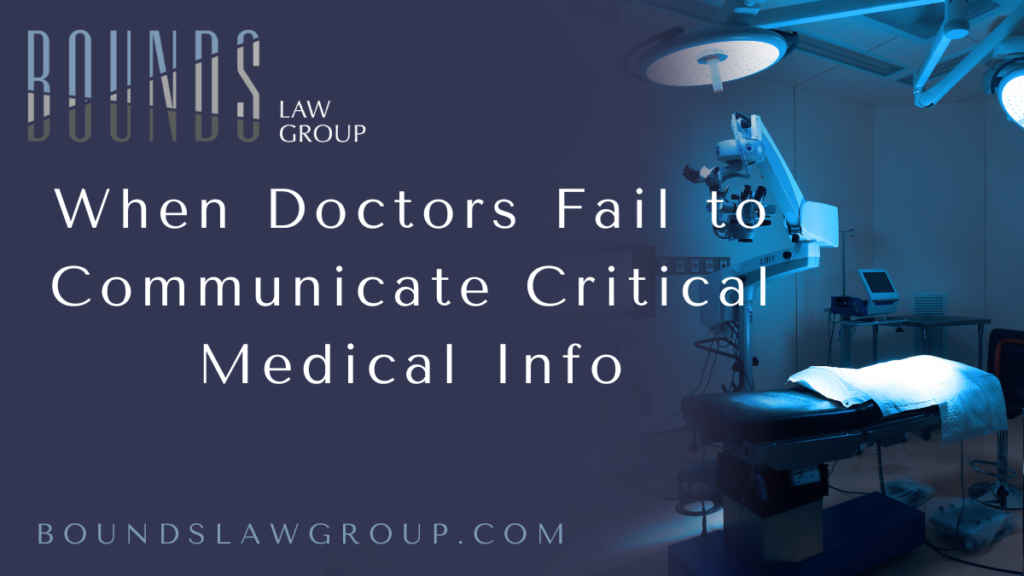
Doctor Communication Failure | Bounds Law Group
In the healthcare system, clear and timely communication between doctors and patients is critical to ensuring proper diagnosis and treatment. However, when doctors fail to communicate vital medical information—whether it's a missed diagnosis, delayed test results, or misunderstood instructions—the consequences can be devastating. A failure to communicate diagnosis can lead to severe health complications, prolonged suffering, or even death. At Bounds Law Group, we understand the life-altering effects of such medical errors and are committed to helping victims seek justice and hold negligent providers accountable for their actions. If you or a loved one has experienced harm due to a communication failure in healthcare, we are here to help guide you through the legal process and pursue the compensation you deserve.
Contact us now at 877-644-5122 or complete the free case evaluation form for expert legal assistance.
What Constitutes a Failure to Communicate Diagnosis?
A failure to communicate diagnosis occurs when a medical professional does not adequately relay essential diagnostic information to the patient. This can happen at any stage of the healthcare process, from failing to inform a patient of test results to omitting critical updates about a developing condition.
Common examples include:
- Not informing a patient of abnormal lab or imaging results.
- Delaying the delivery of a life-altering diagnosis such as cancer or a chronic illness.
- Communicating test results to the wrong patient.
- Failing to follow up or misinterpreting the need for urgent intervention.
This lack of communication often leads to missed treatment windows, worsening conditions, and, in many tragic cases, fatalities.

How Communication Errors Cause Life-Altering Harm
When doctors do not disclose vital medical information in a timely manner, the damage can be extensive. Patients may continue without necessary treatment, engage in risky behaviors they would have avoided had they known their condition, or undergo procedures that are no longer viable due to progression of the illness.
Some of the severe outcomes from a failure to communicate diagnosis include:
- Cancer progression: Early detection is critical for effective treatment. A missed or delayed cancer diagnosis can turn a treatable condition into a terminal one.
- Cardiovascular events: Not communicating results of tests like ECGs or blood pressure readings can lead to heart attacks or strokes.
- Infectious disease spread: Failure to report a diagnosis of a contagious illness can lead to unnecessary outbreaks and complications.
- Mental health deterioration: Patients with untreated psychological conditions may spiral into crisis due to lack of diagnosis disclosure.
These harms are not theoretical—they are real, and they impact thousands every year. At Bounds Law Group, we make it our mission to hold negligent providers accountable.
Legal Standards for Diagnosis Communication
Legally, medical providers are bound by duty of care and ethical obligations to clearly and promptly communicate all relevant information about a patient’s condition. When they fail in this responsibility, they may be held liable for medical malpractice.
In a failure to communicate diagnosis case, several elements must typically be proven:
- A patient-provider relationship existed.
- The provider failed to communicate relevant diagnostic information.
- This failure was a deviation from the standard of care.
- The patient suffered actual harm or injury as a result.
These cases can be complex, requiring an experienced legal team familiar with both the medical field and malpractice litigation.
Why Patients Don’t Always Know They’ve Been Misinformed
Many patients trust that if they haven’t heard back from their provider, everything must be fine. This assumption is dangerous. In reality, numerous diagnosis errors stem from:
- Electronic health record (EHR) system glitches
- Inadequate follow-up procedures
- Overwhelmed hospital staff
- Miscommunications between departments or practitioners
A patient might never know they were diagnosed with something serious—until it’s too late. That’s why we encourage anyone who suspects something went wrong to complete a free case evaluation form and let us review your situation confidentially and thoroughly.
Who Is Liable for a Failure to Communicate Diagnosis?
Liability doesn’t stop at the doctor. Other healthcare professionals and institutions may also be responsible:
- Primary care physicians
- Radiologists who fail to report findings
- Nurses or medical assistants who don’t relay results
- Hospitals that lack proper communication protocols
In some cases, multiple parties share the blame. At Bounds Law Group, we conduct detailed investigations to ensure every responsible party is held accountable.
Statute of Limitations in Failure to Communicate Diagnosis Cases
Every state has laws that limit how long you have to file a medical malpractice claim. These deadlines can range from one to several years depending on jurisdiction and circumstances. Florida, for instance, generally allows two years from the date the injury was discovered—or should have been discovered.
However, exceptions can apply in cases involving fraud, concealment, or minors. Don’t wait to act. Call us today at 877-644-5122 or complete a free case evaluation form.
Proving Damages in a Diagnosis Communication Failure Case
To prevail in a claim for failure to communicate diagnosis, it must be proven that the lack of communication caused significant damages. These may include:
- Extended physical suffering or deterioration
- Increased medical costs due to late treatment
- Lost wages and diminished earning capacity
- Emotional distress and mental anguish
- Permanent disability or death
Our firm works with top medical experts, economists, and life care planners to accurately assess and prove your damages. We do not rest until every angle is considered and your rights are protected.
How Bounds Law Group Fights for Victims of Diagnostic Communication Failures
With decades of experience handling complex medical malpractice claims, Bounds Law Group has earned a reputation for aggressive advocacy, in-depth case preparation, and compassionate client service.
We handle all aspects of your case:
- Investigating the communication failure
- Gathering and analyzing medical records
- Consulting with expert witnesses
- Negotiating with insurers and health systems
- Taking cases to trial when necessary
Our commitment is not only to win your case—but to help you heal, rebuild, and move forward with dignity.
What to Do If You Suspect a Communication Error in Your Diagnosis
If something feels wrong—trust your instincts. Here’s what to do:
- Request all of your medical records immediately.
- Write down everything you remember about appointments and conversations.
- Consult with a medical malpractice attorney as soon as possible.
- Do not confront the provider before seeking legal advice.
Let us help you uncover the truth. Fill out our free case evaluation form or call 877-644-5122 to speak with our legal team directly.
The Role of Technology in Preventing Failure to Communicate Diagnosis
As healthcare systems continue to digitize, technology plays a critical role in reducing the risk of a failure to communicate diagnosis. However, when misused or poorly implemented, it can also contribute to serious communication breakdowns. At Bounds Law Group, we closely examine how digital systems such as Electronic Health Records (EHRs), automated alerts, and patient portals impact the transmission of diagnostic information.
Electronic Health Records (EHRs): Double-Edged Sword
EHRs are designed to centralize and streamline patient information, making it easier for healthcare professionals to access and share data. But these systems are only as effective as the protocols and human actions behind them. Common EHR-related issues include:
- Test results buried in the system and not flagged appropriately.
- Alerts being ignored or overridden by overworked staff.
- Failure to document or review communications within a timely manner.
- Lack of interoperability between systems, resulting in missing or incomplete data.
When a diagnosis is documented in the EHR but never actually communicated to the patient, both the provider and the system may be held responsible for negligence.

Patient Portals: A Useful Tool or a Missed Opportunity?
Many healthcare systems encourage patients to use online portals to view test results and communicate with providers. While this adds convenience, it should never replace direct and timely communication—especially when the results are critical. Patients may:
- Miss email notifications or be unaware they need to log in.
- Misunderstand the medical terminology without proper explanation.
- Fail to take urgent action due to a lack of guidance or follow-up.
Medical professionals are still legally and ethically obligated to follow up with patients directly, particularly when the diagnosis demands urgent or complex medical decisions.
Using Technology Safely and Effectively
Healthcare providers must implement strict protocols to ensure diagnostic information is:
- Actively reviewed and flagged when necessary.
- Communicated through multiple channels, including phone calls and in-person follow-ups.
- Verified through documentation, showing the patient has acknowledged and understood the diagnosis.
At Bounds Law Group, we investigate whether technology helped or hindered diagnosis communication. If a hospital or clinic failed to use their systems responsibly, they can and should be held accountable.
If you believe a technological failure contributed to your misdiagnosis or lack of communication, contact us today by completing our free case evaluation form or calling 877-644-5122. Your health and future deserve answers.
Sources
- Johns Hopkins Medicine
A leader in patient safety research, this source discusses how communication failures are a leading cause of medical errors.
https://www.hopkinsmedicine.org/news/newsroom/news-releases/study-suggests-medical-errors-now-third-leading-cause-of-death-in-the-us - Agency for Healthcare Research and Quality (AHRQ)
Offers comprehensive information on communication breakdowns in healthcare and strategies to mitigate them.
https://psnet.ahrq.gov/primer/communication-failures - National Institutes of Health (NIH)
Provides data and case studies on delayed diagnoses and the resulting health impact.
https://www.ncbi.nlm.nih.gov/pmc/articles/PMC5006147/

